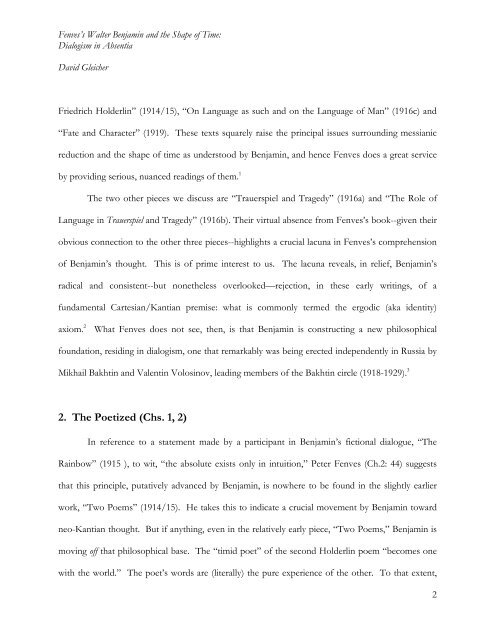Peter Fenves's Walter Benjamin and the Shape ... - Adelphi University
Peter Fenves's Walter Benjamin and the Shape ... - Adelphi University
Peter Fenves's Walter Benjamin and the Shape ... - Adelphi University
Create successful ePaper yourself
Turn your PDF publications into a flip-book with our unique Google optimized e-Paper software.
Fenves’s <strong>Walter</strong> <strong>Benjamin</strong> <strong>and</strong> <strong>the</strong> <strong>Shape</strong> of Time:<br />
Dialogism in Absentia<br />
David Gleicher<br />
Friedrich Holderlin” (1914/15), “On Language as such <strong>and</strong> on <strong>the</strong> Language of Man” (1916c) <strong>and</strong><br />
“Fate <strong>and</strong> Character” (1919). These texts squarely raise <strong>the</strong> principal issues surrounding messianic<br />
reduction <strong>and</strong> <strong>the</strong> shape of time as understood by <strong>Benjamin</strong>, <strong>and</strong> hence Fenves does a great service<br />
by providing serious, nuanced readings of <strong>the</strong>m. 1<br />
The two o<strong>the</strong>r pieces we discuss are “Trauerspiel <strong>and</strong> Tragedy” (1916a) <strong>and</strong> “The Role of<br />
Language in Trauerspiel <strong>and</strong> Tragedy” (1916b). Their virtual absence from Fenves’s book--given <strong>the</strong>ir<br />
obvious connection to <strong>the</strong> o<strong>the</strong>r three pieces--highlights a crucial lacuna in Fenves’s comprehension<br />
of <strong>Benjamin</strong>’s thought. This is of prime interest to us. The lacuna reveals, in relief, <strong>Benjamin</strong>’s<br />
radical <strong>and</strong> consistent--but none<strong>the</strong>less overlooked—rejection, in <strong>the</strong>se early writings, of a<br />
fundamental Cartesian/Kantian premise: what is commonly termed <strong>the</strong> ergodic (aka identity)<br />
axiom. 2 What Fenves does not see, <strong>the</strong>n, is that <strong>Benjamin</strong> is constructing a new philosophical<br />
foundation, residing in dialogism, one that remarkably was being erected independently in Russia by<br />
Mikhail Bakhtin <strong>and</strong> Valentin Volosinov, leading members of <strong>the</strong> Bakhtin circle (1918-1929). 3<br />
2. The Poetized (Chs. 1, 2)<br />
In reference to a statement made by a participant in <strong>Benjamin</strong>’s fictional dialogue, “The<br />
Rainbow” (1915 ), to wit, “<strong>the</strong> absolute exists only in intuition,” <strong>Peter</strong> Fenves (Ch.2: 44) suggests<br />
that this principle, putatively advanced by <strong>Benjamin</strong>, is nowhere to be found in <strong>the</strong> slightly earlier<br />
work, “Two Poems” (1914/15). He takes this to indicate a crucial movement by <strong>Benjamin</strong> toward<br />
neo-Kantian thought. But if anything, even in <strong>the</strong> relatively early piece, “Two Poems,” <strong>Benjamin</strong> is<br />
moving off that philosophical base. The “timid poet” of <strong>the</strong> second Holderlin poem “becomes one<br />
with <strong>the</strong> world.” The poet’s words are (literally) <strong>the</strong> pure experience of <strong>the</strong> o<strong>the</strong>r. To that extent,<br />
2


